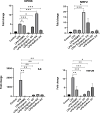Antioxidant, anti-inflammatory, and anti-apoptotic activities of saffron and eryngium honey extracts
- PMID: 40211328
- PMCID: PMC11987237
- DOI: 10.1186/s12906-025-04867-1
Antioxidant, anti-inflammatory, and anti-apoptotic activities of saffron and eryngium honey extracts
Abstract
Saffron and Eryngium honeys are unique types of monofloral honeys collected from eastern and center of Iran. In present study, first, we investigated melissopalynological and physicochemical parameters in honey samples. Then we extracted the phenolic compounds and evaluated in vitro antioxidant by FRAP assay and anti-inflammatory activities by lipopolysaccharide induced RAW 264.7 macrophage cells. Phenolic extracts reduced nitric oxide and the secretion of the inflammatory cytokines IL-6 and TNFSF9 in the inflamed cells, and by reducing the NF-kB and increasing Nrf2 gene expression, showed an anti-inflammatory effect, but in general, Eryngium honey showed higher anti-inflammatory properties. Also, by studying the expression of Bcl-2, Bax and HO-1 genes, we showed that there is a relationship between inflammation and apoptosis in macrophage cells that the phenolic compounds showed their anti-apoptotic properties. Eryngium honey had a better performance in anti-apoptotic properties. Moreover, promising results indicate that Iranian honeys could be an important source of phenolic compounds presenting antioxidant and anti-inflammatory activity, which can have health-promoting properties if included in the diet and medicine.
Keywords: Bcl-2; TNFSF9; Anti-inflammatory; Antioxidant; Eryngium honey; Saffron honey.
© 2025. The Author(s).
Conflict of interest statement
Declarations. Ethics approval and consent to participate: Not applicable. Consent for publication: Not applicable. Competing interests: The authors declare no competing interests.
Figures





Similar articles
-
Investigation of phenolic compounds, antioxidant and anti-inflammatory activities in stingless bee honey (Meliponinae).Food Res Int. 2020 Mar;129:108756. doi: 10.1016/j.foodres.2019.108756. Epub 2019 Nov 27. Food Res Int. 2020. PMID: 32036884
-
Phenolic profile and in vitro anti-inflammatory activity of Mimosa scabrella Bentham honeydew honey in RAW 264.7 murine macrophages.J Food Biochem. 2022 Feb;46(2):e14076. doi: 10.1111/jfbc.14076. Epub 2022 Jan 7. J Food Biochem. 2022. PMID: 34997588
-
Antioxidant and anti-inflammatory potential of rhizome aqueous extract of sea holly (Eryngium maritimum L.) on Jurkat cells.J Ethnopharmacol. 2023 Apr 6;305:116120. doi: 10.1016/j.jep.2022.116120. Epub 2023 Jan 4. J Ethnopharmacol. 2023. PMID: 36610674
-
Monofloral Honeys as a Potential Source of Natural Antioxidants, Minerals and Medicine.Antioxidants (Basel). 2021 Jun 25;10(7):1023. doi: 10.3390/antiox10071023. Antioxidants (Basel). 2021. PMID: 34202118 Free PMC article. Review.
-
An overview of physicochemical characteristics and health-promoting properties of honeydew honey.Food Res Int. 2019 May;119:44-66. doi: 10.1016/j.foodres.2019.01.028. Epub 2019 Jan 16. Food Res Int. 2019. PMID: 30884675 Review.
Cited by
-
Honey as a Neuroprotective Agent: Molecular Perspectives on Its Role in Alzheimer's Disease.Nutrients. 2025 Aug 8;17(16):2577. doi: 10.3390/nu17162577. Nutrients. 2025. PMID: 40871605 Free PMC article. Review.
References
-
- White JW Jr, Honey. Adv Food Nutr Res. 1978;24:287–374. - PubMed
-
- Ballabio D, Robotti E, Grisoni F, Quasso F, Bobba M, Vercelli S, et al. Chemical profiling and multivariate data fusion methods for the identification of the botanical origin of honey. Food Chem. 2018;266:79–89. - PubMed
-
- Manzanares AB, García ZH, Galdón BR, Rodríguez ER, Romero CD. Physicochemical characteristics of minor monofloral honeys from Tenerife, Spain. LWT-Food Sci Technol. 2014;55(2):572–8.
-
- Harborne JB, Harborne J. Phenolic compounds. Phytochemical methods: A guide to modern techniques of plant analysis. 1973:33–88.
MeSH terms
Substances
LinkOut - more resources
Full Text Sources
Medical
Research Materials
Miscellaneous

